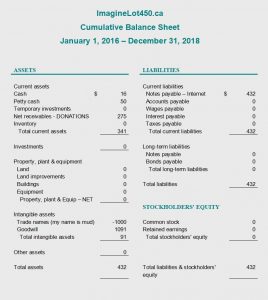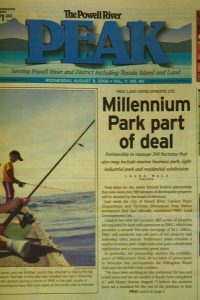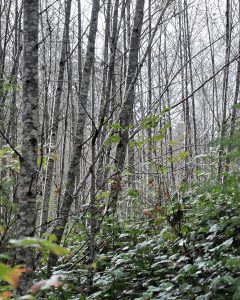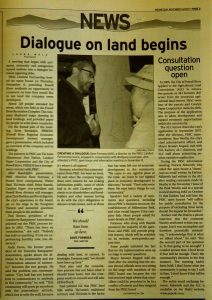
Here’s an adult female Vancouver Island marmot (Marmota vancouverensis) photographed at Haley Lake Ecological Reserve, 29 April 1996. She’s just burrowed through about 2 metres of snow to see daylight for the first time in about 210 days. Judging from the footprints, I missed her emergence by a few hours.
Forensic accounting is hard.
The PRSC is history
So we move on. As is true in matters of love, sports teams and haircuts, I think humans are optimists by nature, reasoning that things just have to get better.
Because we’re smarter now, right?
We’ve learned from experience, right?
Sadly, history teaches us that this is not always true.
And as Bill Murray so wonderfully showed us, sometimes it takes more than a few successive Groundhog Days before the lessons truly sink in.
Accounting 101
This is where things become interesting. Were I an accountant, I’d start by asking questions like:
- where’s the balance-sheet? After all, PRSC was responsible for a large chunk of “Lot 450” from the time of its inception until its dissolution in 2018. How much money did it make? How much did it lose? In financial terms, was PRSC a successful business?
But I’m an ecologist, so I don’t think in purely financial terms. Indeed my training and curiosity demands that I also ask:
- where’s the ecological balance-sheet? Are conditions on the land better than they were? Have the PRSC subscribed to “best standards” in terms of managing the lands during their decade of landownership? Did they show vision?
Lastly, I’m a taxpayer, resident of Powell River, and amateur historian.
- where’s the social balance-sheet? What did PRSC do to us? What did it do to trust in our local government?
So. We don’t need a “balance-sheet”. We need three of them. Here goes.
The Financial balance-sheet

In a perfect world this would be easy. Tally income from land sales, deduct expenses, factor in land appreciation/depreciation over time, and come up with a dollar value. Governments do it all the time. Businesses do it all the time.
But because PRSC was structured as a Limited Partnership with three shareholders (two after Catalyst left), well this gets harder.
I would assume that PRSC provided such reporting to their shareholders. But to my knowledge there’s been no publicly-released balance sheet – ever.
So we’re left trying to guestimate from what we do know. This is not a happy state-of-affairs for someone like me, who loves data.

This is the earliest published reference that I can find for the PRSC…despite having been established three months earlier, in May.
Powell River Peak, 9 Aug 2006
PRSC sold three properties on the “open market” (Timberlane Estates, Cranberry Farm and Wildwood Hill). One sold for $260,000 (Timberlane), and another for $330,000 (Wildwood Hill). We know of other deals that came up – and fell through.
It’s not hard to find references to “accepted offers” or “interested buyers” here and there. But in the end, that was it. The PRSC sold three properties on the “open market”.
We also know that the City aquired PRSC lands. Millennium Park was part of the provincial deal struck when Weyerhaeuser bought MacMillan Bloedel back in 1999 – that’s what made the headlines when PRSC was first announced six years later, in 2006.
There were two other properties aquired by the City. What I still call the “Sino Bright parcel” was purchased in 2017 (for $800,000), as was a portion of “Waterfront A” (for $175,000).

The above is from the “Watchdog Bulletin”, Vol. 1 ,Issue 1. , which was published in February of 2006.
It’s impossible to build a balance-sheet from these data. We know nothing of property taxes paid, or interest, or any of the other line-items that make up a typical financial balance-sheet.
The lack of fiscal transparency made PRSC controversial from the start. Patricia Aldworth, whom we’ll meet again, published a series of email newsletters in 2006-2007. Many of these were focussed on what she called the “Joint Venture”.
Never one to mince words, Ms. Aldworth was asking tough questions right from the start. Thirteen years later, what strikes me about her list was specific reference to:
“legal and financial risks to taxpayers” and
“public reporting of financial position”.
Because, in the end, we got a whole lot of the former, and none of the latter.
So. Was PRSC a successful business in financial terms?
The “preponderance of evidence” would suggest “NO”.
Did PRSC put taxpayers at “legal and financial” risk? “YES”.
The Ecological balance-sheet

Despite the fact that proposed development involved no lands south of Wildwood, the feeling appears to have been “well, if we’re going to apply for an ALR exclusion…why don’t we ask for all of it?”
PRSC seldom made decisions with ecological principles in mind – but to be fair, that was never their mandate.
There are some successes to report. First and foremost is Millennium Park. It was forced upon them, admittedly, but they didn’t hinder it. And while options were discussed, no forest harvesting occurred within it.
Many of the PRSC lands were part of the Agricultural Land Reserve (ALR) – and here the report-card is not so favorable. Indeed, the ALR was generally considered to be an impediment to what were perceived to be the “highest and best use” of land.
If you take time to read the ALC Decision, it was Yrainucep that “anchored” the City’s application to remove 343 hectares from the ALR – even though that development only concerned lands in Wildwood.
But as Dave Formosa, then on the PRSC Board of Directors and also President of the Powell River Chamber of Commerce, put it:
“If we don’t take it out of the ALR, how can we move forward? What was the purpose of the whole thing?”
Yes. Maintaining forests, agricultural potential, biodiversity, and life-support systems on Planet Earth can be a right pain-in-the-ass.

Forest conditions (and land values) could have been improved under the watch of an astute landowner.
So far as I can determine, there were no serious attempts made to “improve” the lands under PRSC control during the twelve years of their tenure.
For example, there were no efforts to treat the post-harvest patches that were harvested by MacMillan-Bloedel & Weyerhaeuser in 1999-2000. These are now overgrown thickets of blackberry and alder instead of healthy young forests of fir and hemlock.
Nor was there any made to pursue the legal question raised about tree ownership, as reported here. So far as PRSC was concerned it was simpler just to accept that “Island Timberlands owns the trees”.
And then there’s the “looped road” issue. This frankly just baffles me. Quite apart from the ALR transgression, this was effectively giving away 2 acres of forested land. Or…was it given away? We don’t know. That’s not on the public record either.
Ultimately, from an ecological perspective, I think two broad conclusions can be safely drawn.
- the ALC was effective in “watching our back” and prevented more substantial damage to the lands in question, and
- in terms of ecological “stewardship” or “vision for the land”, PRSC was pretty much “asleep at the wheel”.
The Social balance-sheet

Alas, this was “too little, too late” to alter public opinion on the subject.
Indeed, Yrainucep Development Corporation had announced their departure from land consultations – a week earlier.
Powell River Peak, 14 Nov 2007
This is perhaps the “meat” of it. It’s not my “area of expertise” – I’m neither a psychologist or sociologist. But I think someone needs to say it. The true cost of the PRSC has been the loss of trust in local government.
- Prior to public announcement of PRSC in 2006, there was already a major land development “in the works”.
- Prior to the announcment of Yrainucup, there was already an ALR exclusion application “in the works”.
- Simultaneously a Director of PRSC was in the process of suing an individual who, so far as I can tell, was merely trying to inform people about matters of public policy.
Fast forward a few years to 2015, and now there’s a new deal on the table: Sino Bright
This time around lessons have been learned. Public hearings on the ALR exclusion are held.
After an agreement to sell the lands had already been made…and after people have noticed that there’s a suspicious-looking road on the ALR, and that the proposed exclusion would make
the problem go away.
I could go on…in recent months there’s been another land-sale to Sino Bright, which was signed on the same day that PRSC dissolved itself. Coincidence?
In the end
Perhaps it’s fitting to wrap this up with another gem from the Peak:
“This is what has been missing from the whole process all along: public input, a way for the public to feel consulted, if not involved in decisions that impact their community. A dialogue has begun and hopefully our elected officials will not only realize this is a necessary part of the equation, but will act to expand the conversation.”
That’s from an op-ed published on 7 Jan 2007.
Welcome to Powell River.
Where every day is Groundhog Day.

